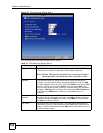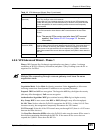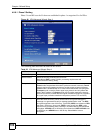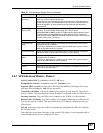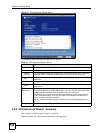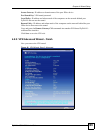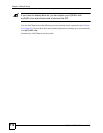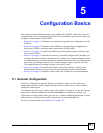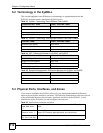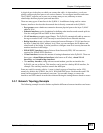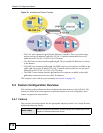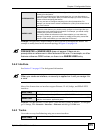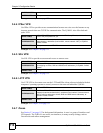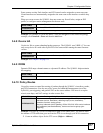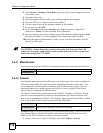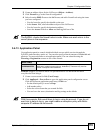
Chapter 5 Configuration Basics
ZyWALL USG 1000 User’s Guide
112
5.2 Terminology in the ZyWALL
This section highlights some differences in terminology or organization between the
ZyWALL and other routers, particularly ZyNOS routers.
5.3 Physical Ports, Interfaces, and Zones
If you want to configure the ZyWALL effectively, you should understand the differences
between physical ports, interfaces, and zones. The following illustration provides an overview
of the relationship between physical ports, interfaces, and zones in the ZyWALL. It also
identifies the types of features you can configure with each one.
Table 22 ZyWALL Terminology That is Different Than ZyNOS
ZYNOS FEATURE / TERM ZYWALL FEATURE / TERM
Port forwarding Virtual server
IP alias Virtual interface
Gateway policy VPN gateway
Network policy (IPSec SA) VPN connection
Table 23 ZyWALL Terminology That Might Be Different Than Other Products
FEATURE / TERM ZYWALL FEATURE / TERM
Destination NAT (DNAT) Virtual server
Source NAT (SNAT) Policy route
Hub-and-spoke VPN (VPN) concentrator
Table 24 NAT: Differences Between the ZyWALL and ZyNOS
ZYNOS FEATURE / SCREEN ZYWALL FEATURE / SCREEN
Port forwarding Virtual server
Trigger port, port triggering Policy route
Address mapping Policy route
Address mapping (VPN) IPSec VPN
Table 25 Bandwidth Management: Differences Between the ZyWALL and ZyNOS
ZYNOS FEATURE / SCREEN ZYWALL FEATURE / SCREEN
Interface bandwidth (outbound) Interface
OSI level-7 bandwidth Application patrol
General bandwidth Policy route
Table 26 Physical Ports, Interfaces, and Zones
Zones
(LAN, DMZ, WAN,
...)
Used in firewall, IDP, remote management, anti-virus, ADP, application
patrol
Interfaces
(Ethernet, VLAN,...)
Used in VPN, zones, trunks, device HA, DDNS, policy routes, static
routes, HTTP redirect, application patrol, and virtual server
Physical Ports
(P1, P2, P3, P4, P5)
Used in port groups.



